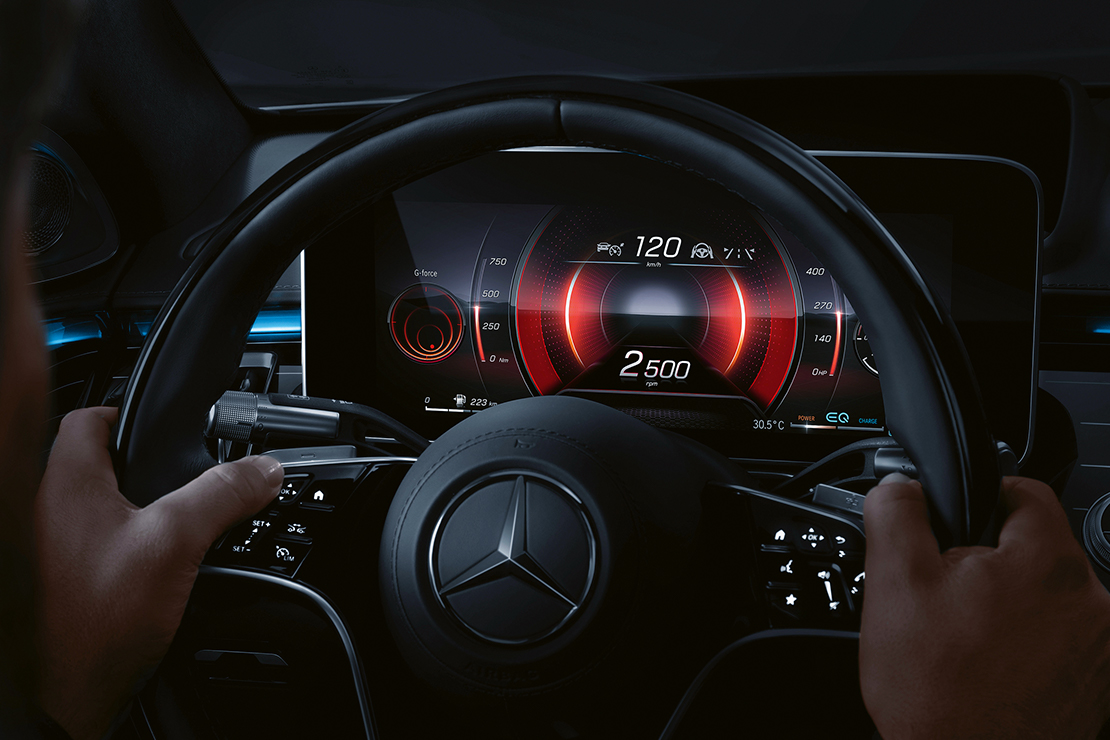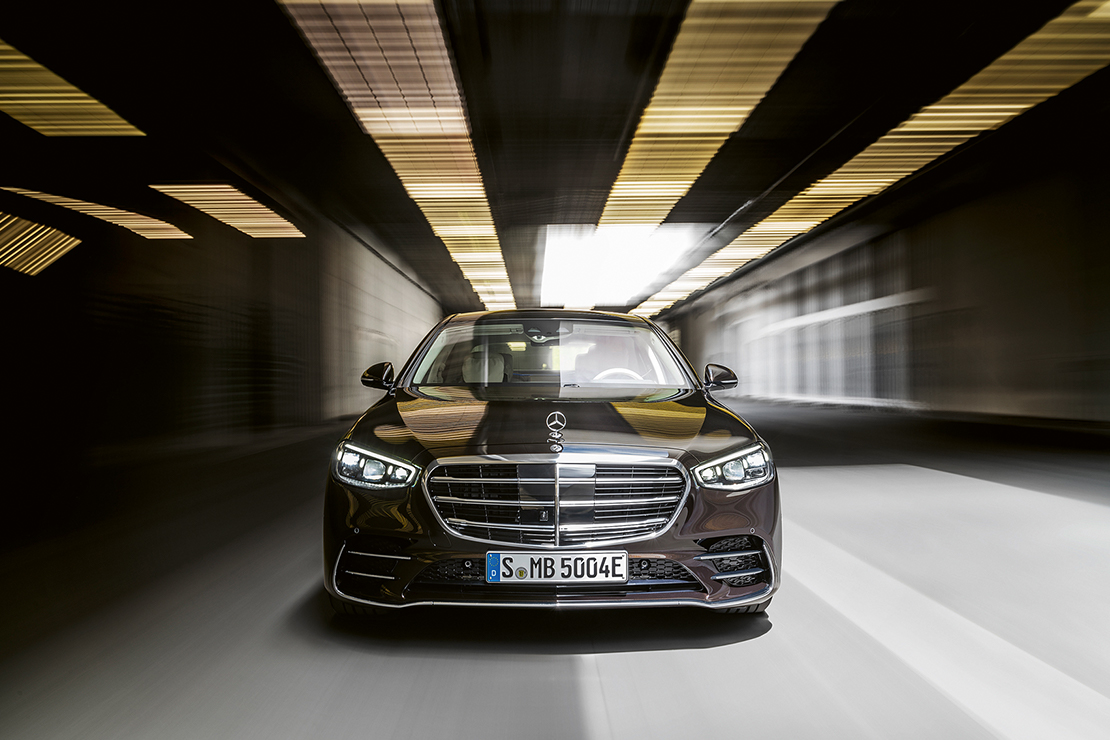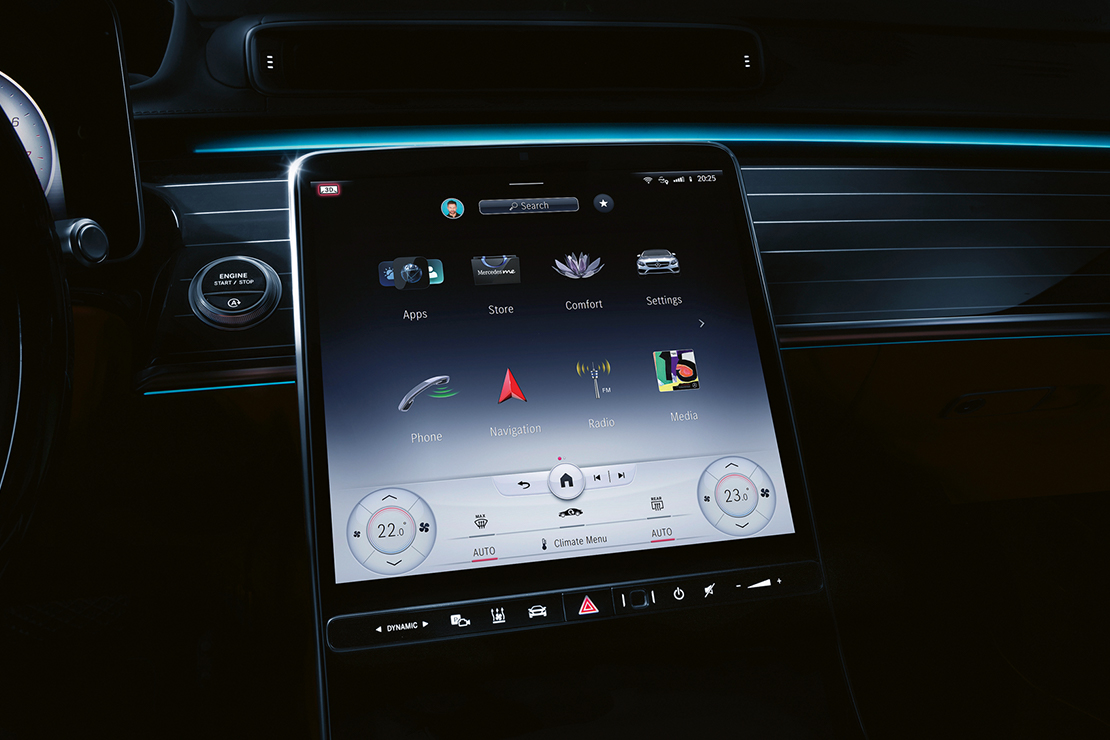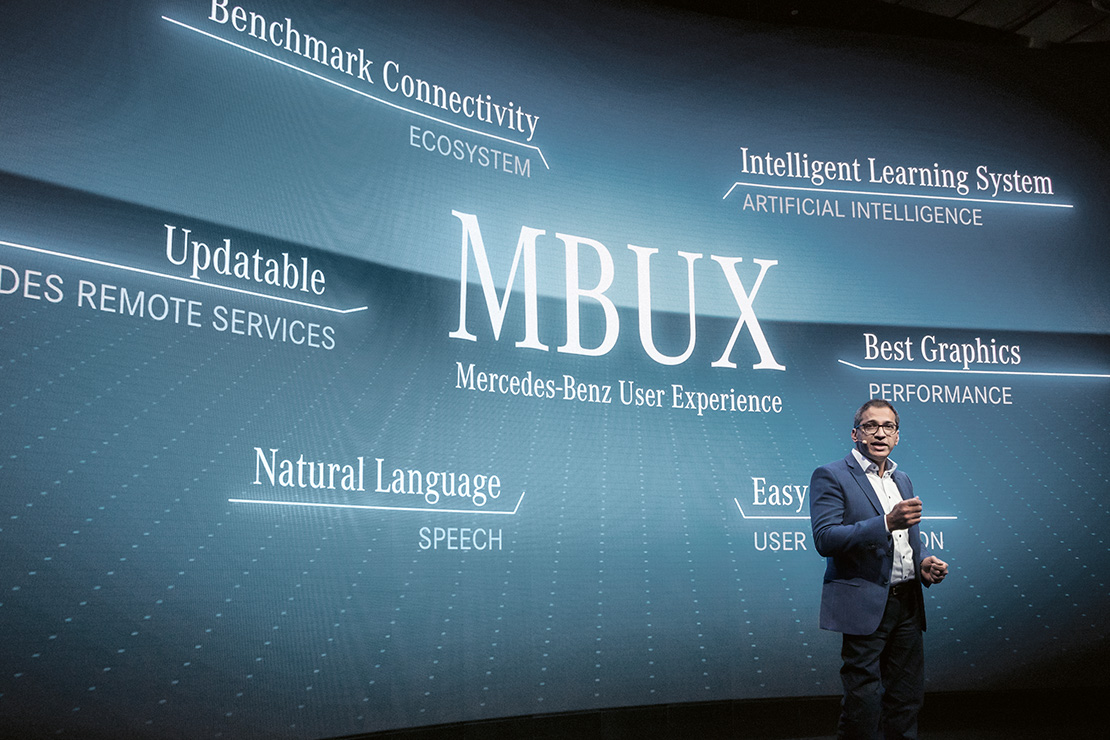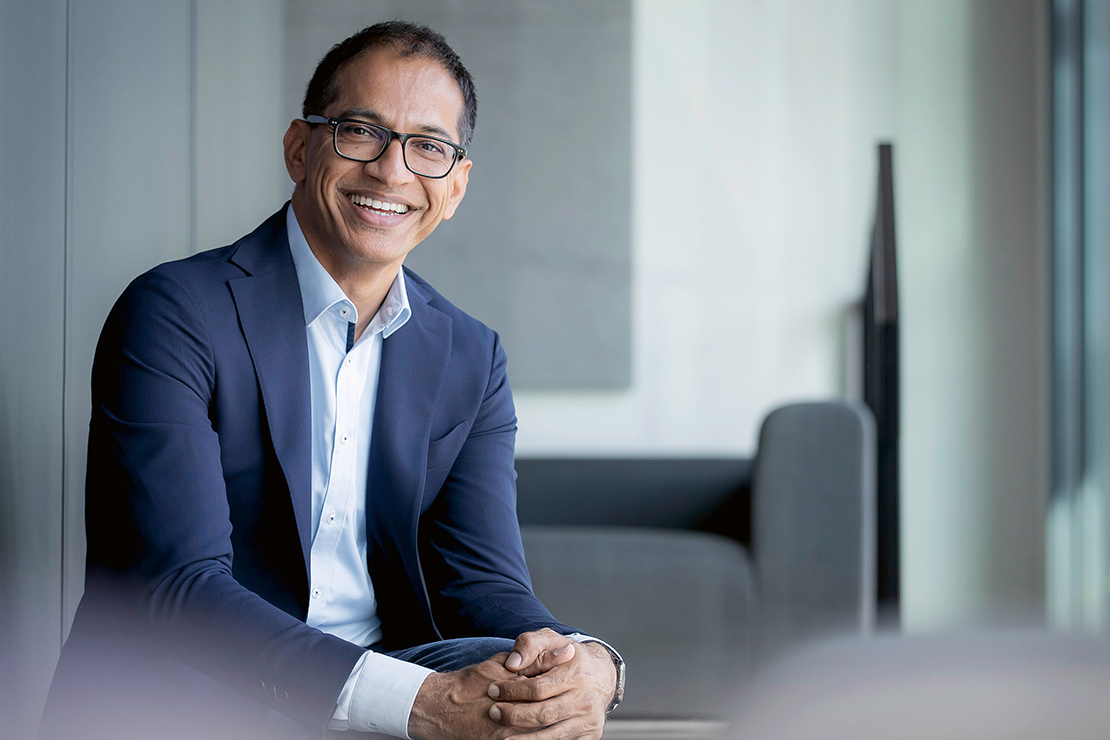
In dialog with Sajjad Khan
CTO, Member of the Board of Management, Mercedes-Benz AG
For Mercedes-Benz, the inventor of the car, the goal for the upcoming years is clear: leading the development with regard to the future topics of electrification and car software. The company is aiming to take the lead with ambitious product development targets and the accelerated introduction of new technology. In the area of car software, the German automaker has announced its own proprietary MBOS operating system.
Mr. Khan, your strategy is designed to avoid non-core activities to focus on winning where it matters: dedicated electric vehicles and proprietary car software. Why does vehicle software play such a central role to continue to be successful?
It’s not that long ago that a clear distinction was made between classic industry and future-oriented sectors such as IT. The past few years have clearly shown us that this distinction between the new and old economy no longer makes sense. Our company offers a textbook example of this: whereas in times past our focus was mainly on steel and mechanical work, nowadays the use of software and state-of-the-art electronics is just as important – or possibly even more important. The same applies to the question of what luxury is. Luxury nowadays does not just mean using the highest-quality materials in the interior; luxury is also about having the most advanced car software on board. And this is our goal for every Mercedes-Benz car.
You and your team are working on a new computing architecture for Mercedes-Benz. What is the benefit for the customer?
We always put our customers in the center of our thinking, when we develop new technologies, products and services. And with a new computing architecture the keyword here is MBOS – Mercedes-Benz Operating System. Just as with the electric drivetrain and with battery technology, we have to be masters over the software and electronics in our vehicles. In contrast to a smartphone perhaps, where you can change the hardcase, in automotive manufacturing hard- and software are two sides of the same coin. This applies in particular to the premium and luxury segment, where the customer wants to stand out from the crowd, is looking for that special something.
This is why we want to put a proprietary, data-supported Mercedes-Benz Operating System into our vehicles by 2024, thus intelligently networking the vehicle with the Cloud and the IoT world. Only when we have control over the software platform via the domains in the vehicle, all the way through to the Cloud and the IoT world, will we draw long-term benefit from sales, for example by being able to offer new functions via over-the-air updates. This is where we talk about digital recurrent revenues. We will benefit from this model, and so will our customers, because we can react more quickly and flexibly to their needs than ever before. The positive side effect: we retain our customers over the long run. This secures us profitability from the follow-up business as well. And the customers know that they are getting everything from a single source – in Mercedes-Benz quality.
In 2018 you introduced the new infotainment system MBUX and the media worldwide agreed, that you have set a new standard with MBUX. Was this system the first step towards developing car software?
You are right; the good thing here is that today we are not starting from scratch. I would even go one-step further back – already back in 2016 we had the first over-the-air updates in the E-Class. With the MBUX system, introduced at the beginning of 2018, we set standards in terms of ease of use and intelligent networking. As far as the electrification of vehicles is concerned, the interplay of technologies is impossible without the use of intelligent software. And if you look at the new Mercedes-Benz S-Class, with its software architecture and the associated MBUX system – what I call MyMBUX – it demonstrates in impressive style that this goal is not just pie in the sky.
The technology in the car represents a quantum leap in terms of performance, innovative features and intuitive operation, including as it does augmented reality and the very finest sensor systems. This is not about gizmos and technical gimmicks, instead the aim is to offer the customer more comfort, safety, freedom and luxury. So you see, step by step, we create and develop the Mercedes-Benz car software further. And believe me, this is by far not the end of the line!
Okay, now you made us curious, what are the next upcoming steps?
We already talked about infotainment and MBUX, but the computing architecture includes an entire bundle of domains in the vehicle: the drive, the entire vehicle control system, automated driving functions, communications and – as mentioned – infotainment. As an OEM, we define the standards and thus retain control over the integration of all systems and software. Nowadays, software in the car is like the blood flowing through our veins: finely ramified in each component – nothing functions without it.
Therefore, car software is not just key when it comes to comfort, safety and infotainment, but is the heart and brain all in one when it comes to automated driving. In this area, too, we rely on strategic partnerships with the best technology companies: in this case with NVIDIA, the global leading provider of GPU-accelerated computing. This means superb, high-speed computing applications. From 2024, this technology is to be introduced across all Mercedes-Benz model series in order to make upgradeable automated driving functions available in our next-generation vehicles.
But Mercedes-Benz customers do not need to wait until 2024 to get the first automated driving function into their vehicles?
We will take our first step towards automated driving – subject to approval by the relevant authorities – in the second half of 2021: this is when the S-Class will be equipped with the new DRIVE PILOT. This technology enables conditionally automated driving (SAE Level 3), thanks to the use of high-tech lidar sensors and HD road maps. The driver can have the car take over driving, initially up to the legally stipulated limit of 60 km/h. Depending on the development of the legal situation; the system will be approved in other markets and activated for higher speeds. In addition, thanks to the technology already installed in the S-Class, it is already equipped for Level 4 in relation to “autonomous” parking in parking garages, as we demonstrated last fall along with Bosch and APCOA in a parking garage at Stuttgart Airport.
Over the last decades, your “traditional” competitors have been other OEMs like BMW and AUDI. With developing car software and automated driving functions the field of competitors is changing, from the automotive industry to the big tech companies. Are you afraid when you are looking towards Silicon Valley or the Chinese software giants?
Those who have had the pleasure of experiencing the technology in the new S-Class know that we have no need to look in awestruck reverence towards Silicon Valley and China. In the Neckar Valley and in Sindelfingen we, too, have the best people and the best prerequisites. At the same time, we are expanding our network of locations with software expertise. We also have top teams in Berlin, Seattle, Beijing, Tokyo, Bangalore and Tel Aviv, to combine our worldwide experience in cloud computing, car IT security, software start-ups and Asian specific requirements in a perfect way. Because we know, that a highly qualified team is required to develop the MBOS in-house in our worldwide digital hubs. Therefore, we also have expanded our qualifications portfolio with respect to software. This includes training offers from internal as well as from external training providers like Udacity and Quofox from beginner to expert levels.
The electrification and digitalization of our vehicles are
central components of our strategy and transformation. Therefore, the future of Mercedes-Benz is electric and digital!
Talking about car software, data security also plays an important role. What is Mercedes-Benz doing in this field?
You are absolutely right – this issue is very important to me in all of this: dealing responsibly with data at Mercedes-Benz is not just a sign of our quality standards, but is also part of our all-encompassing understanding of the true meaning of sustainability. That is why we follow a holistic data governance approach for all our developments. As part of this we not only want to offer our customers new services, but also the assurance of convenient and, above all else, secure data handling.
Looking into the nearer future – what’s coming next?
The electrification and digitalization of our vehicles are central components of our strategy and transformation. Therefore, the future of Mercedes-Benz is electric and digital! And our next product highlight, the EQS will be a clear proofpoint. The first model built on our new, dedicated electric vehicle architecture “EVA” will allow customers in the luxury segment to fully benefit from all the advantages of an all-electric architecture with respect to space and design. With ranges of more than 700 km (according to WLTP), the electric vehicles also use pioneering cross-sectoral technologies from Mercedes-Benz such as a new generation of MBUX, completely new designed displays or the driving assistance systems. And of course, the new EQS will have the latest version of Mercedes-Benz software!

